2014 KIA Sedona warning light
[x] Cancel search: warning lightPage 80 of 382
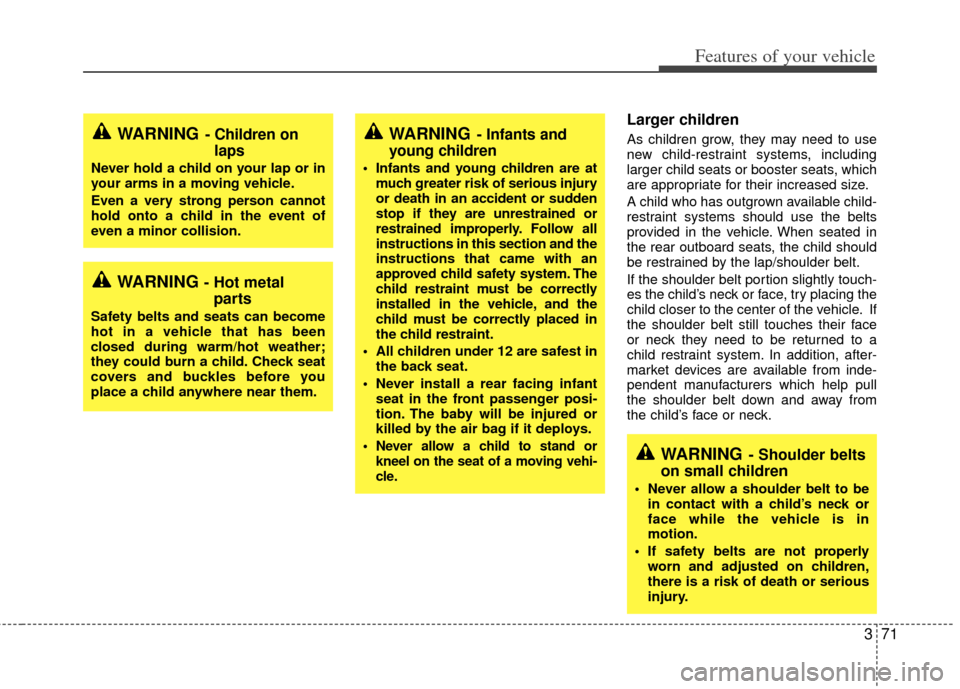
371
Features of your vehicle
Larger children
As children grow, they may need to use
new child-restraint systems, including
larger child seats or booster seats, which
are appropriate for their increased size.
A child who has outgrown available child-
restraint systems should use the belts
provided in the vehicle. When seated in
the rear outboard seats, the child should
be restrained by the lap/shoulder belt.
If the shoulder belt portion slightly touch-
es the child’s neck or face, try placing the
child closer to the center of the vehicle. If
the shoulder belt still touches their face
or neck they need to be returned to a
child restraint system. In addition, after-
market devices are available from inde-
pendent manufacturers which help pull
the shoulder belt down and away from
the child’s face or neck.WARNING- Infants and
young children
Infants and young children are at
much greater risk of serious injury
or death in an accident or sudden
stop if they are unrestrained or
restrained improperly. Follow all
instructions in this section and the
instructions that came with an
approved child safety system. The
child restraint must be correctly
installed in the vehicle, and the
child must be correctly placed in
the child restraint.
All children under 12 are safest in the back seat.
Never install a rear facing infant seat in the front passenger posi-
tion. The baby will be injured or
killed by the air bag if it deploys.
Never allow a child to stand or
kneel on the seat of a moving vehi-
cle.WARNING- Shoulder belts
on small children
Never allow a shoulder belt to be
in contact with a child’s neck or
face while the vehicle is in
motion.
If safety belts are not properly worn and adjusted on children,
there is a risk of death or serious
injury.
WARNING- Children onlaps
Never hold a child on your lap or in
your arms in a moving vehicle.
Even a very strong person cannot
hold onto a child in the event of
even a minor collision.
WARNING - Hot metal parts
Safety belts and seats can become
hot in a vehicle that has been
closed during warm/hot weather;
they could burn a child. Check seat
covers and buckles before you
place a child anywhere near them.
Page 82 of 382
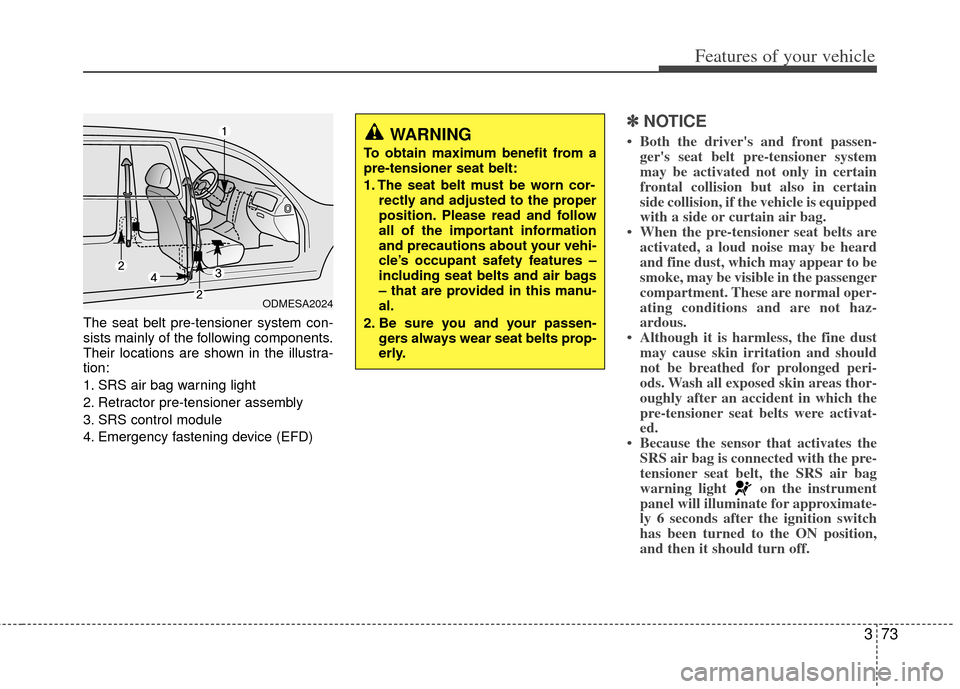
373
Features of your vehicle
The seat belt pre-tensioner system con-
sists mainly of the following components.
Their locations are shown in the illustra-
tion:
1. SRS air bag warning light
2. Retractor pre-tensioner assembly
3. SRS control module
4. Emergency fastening device (EFD)
✽ ✽NOTICE
• Both the driver's and front passen-
ger's seat belt pre-tensioner system
may be activated not only in certain
frontal collision but also in certain
side collision, if the vehicle is equipped
with a side or curtain air bag.
• When the pre-tensioner seat belts are activated, a loud noise may be heard
and fine dust, which may appear to be
smoke, may be visible in the passenger
compartment. These are normal oper-
ating conditions and are not haz-
ardous.
• Although it is harmless, the fine dust may cause skin irritation and should
not be breathed for prolonged peri-
ods. Wash all exposed skin areas thor-
oughly after an accident in which the
pre-tensioner seat belts were activat-
ed.
• Because the sensor that activates the SRS air bag is connected with the pre-
tensioner seat belt, the SRS air bag
warning light on the instrument
panel will illuminate for approximate-
ly 6 seconds after the ignition switch
has been turned to the ON position,
and then it should turn off.
ODMESA2024
WARNING
To obtain maximum benefit from a
pre-tensioner seat belt:
1. The seat belt must be worn cor-
rectly and adjusted to the proper
position. Please read and follow
all of the important information
and precautions about your vehi-
cle’s occupant safety features –
including seat belts and air bags
– that are provided in this manu-
al.
2. Be sure you and your passen- gers always wear seat belts prop-
erly.
Page 83 of 382
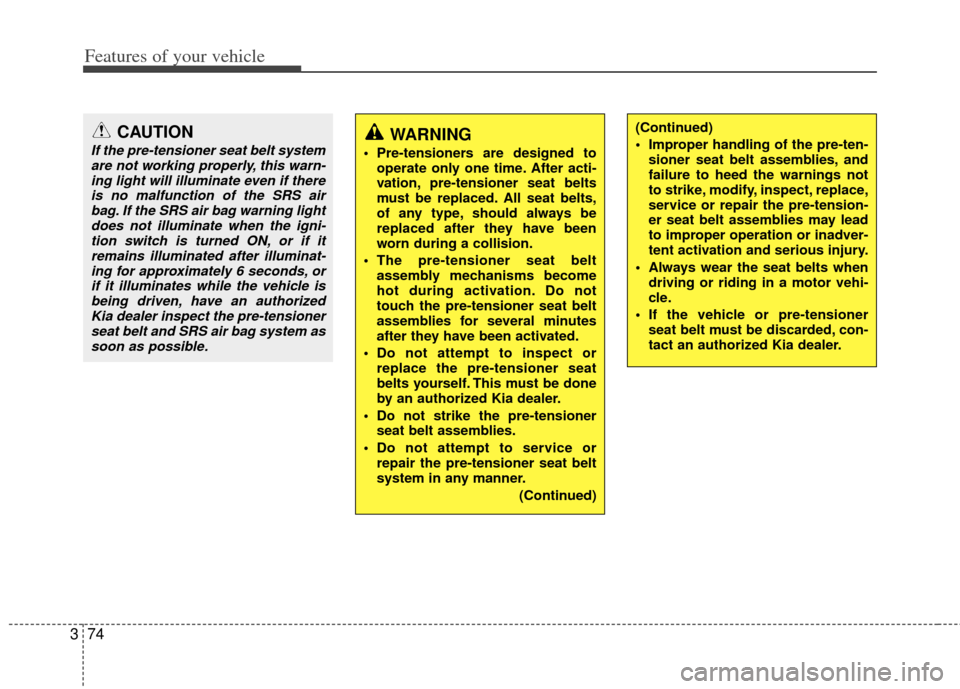
Features of your vehicle
74
3
CAUTION
If the pre-tensioner seat belt system
are not working properly, this warn-ing light will illuminate even if thereis no malfunction of the SRS airbag. If the SRS air bag warning light does not illuminate when the igni-tion switch is turned ON, or if itremains illuminated after illuminat-ing for approximately 6 seconds, orif it illuminates while the vehicle isbeing driven, have an authorizedKia dealer inspect the pre-tensionerseat belt and SRS air bag system as soon as possible.WARNING
Pre-tensioners are designed to operate only one time. After acti-
vation, pre-tensioner seat belts
must be replaced. All seat belts,
of any type, should always be
replaced after they have been
worn during a collision.
The pre-tensioner seat belt assembly mechanisms become
hot during activation. Do not
touch the pre-tensioner seat belt
assemblies for several minutes
after they have been activated.
Do not attempt to inspect or replace the pre-tensioner seat
belts yourself. This must be done
by an authorized Kia dealer.
Do not strike the pre-tensioner seat belt assemblies.
Do not attempt to service or repair the pre-tensioner seat belt
system in any manner.
(Continued)
(Continued)
Improper handling of the pre-ten-sioner seat belt assemblies, and
failure to heed the warnings not
to strike, modify, inspect, replace,
service or repair the pre-tension-
er seat belt assemblies may lead
to improper operation or inadver-
tent activation and serious injury.
Always wear the seat belts when driving or riding in a motor vehi-
cle.
If the vehicle or pre-tensioner seat belt must be discarded, con-
tact an authorized Kia dealer.
Page 84 of 382
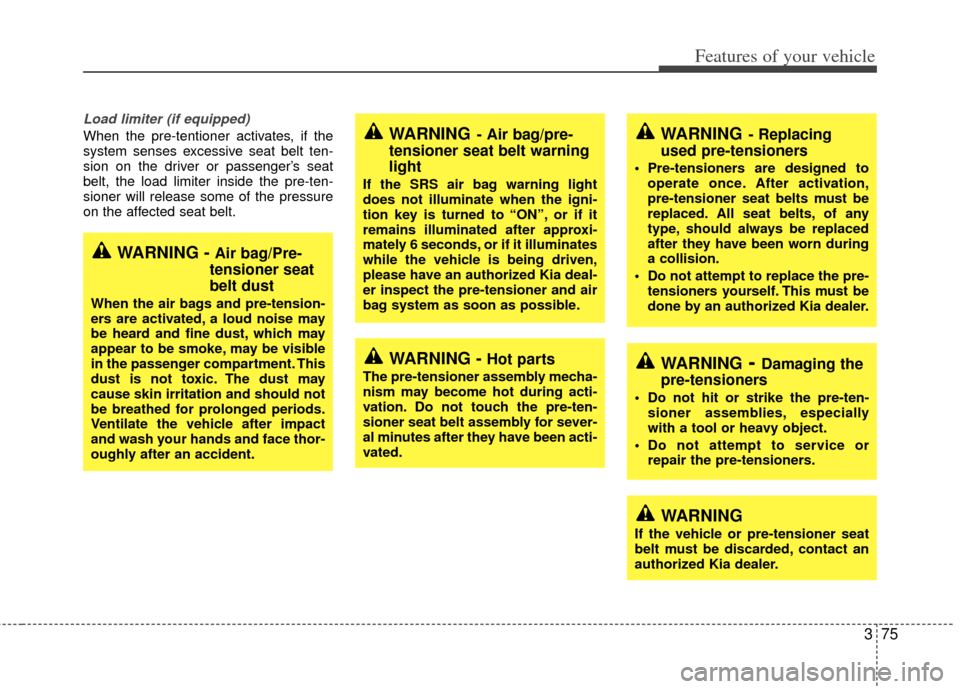
375
Features of your vehicle
Load limiter (if equipped)
When the pre-tentioner activates, if the
system senses excessive seat belt ten-
sion on the driver or passenger’s seat
belt, the load limiter inside the pre-ten-
sioner will release some of the pressure
on the affected seat belt.WARNING- Air bag/pre-
tensioner seat belt warning
light
If the SRS air bag warning light
does not illuminate when the igni-
tion key is turned to “ON”, or if it
remains illuminated after approxi-
mately 6 seconds, or if it illuminates
while the vehicle is being driven,
please have an authorized Kia deal-
er inspect the pre-tensioner and air
bag system as soon as possible.
WARNING - Hot parts
The pre-tensioner assembly mecha-
nism may become hot during acti-
vation. Do not touch the pre-ten-
sioner seat belt assembly for sever-
al minutes after they have been acti-
vated.
WARNING
If the vehicle or pre-tensioner seat
belt must be discarded, contact an
authorized Kia dealer.
WARNING- Replacing
used pre-tensioners
Pre-tensioners are designed to
operate once. After activation,
pre-tensioner seat belts must be
replaced. All seat belts, of any
type, should always be replaced
after they have been worn during
a collision.
Do not attempt to replace the pre- tensioners yourself. This must be
done by an authorized Kia dealer.
WARNING- Damaging the
pre-tensioners
Do not hit or strike the pre-ten-
sioner assemblies, especially
with a tool or heavy object.
Do not attempt to service or repair the pre-tensioners.
WARNING -Air bag/Pre-
tensioner seat
belt dust
When the air bags and pre-tension-
ers are activated, a loud noise may
be heard and fine dust, which may
appear to be smoke, may be visible
in the passenger compartment. This
dust is not toxic. The dust may
cause skin irritation and should not
be breathed for prolonged periods.
Ventilate the vehicle after impact
and wash your hands and face thor-
oughly after an accident.
Page 93 of 382
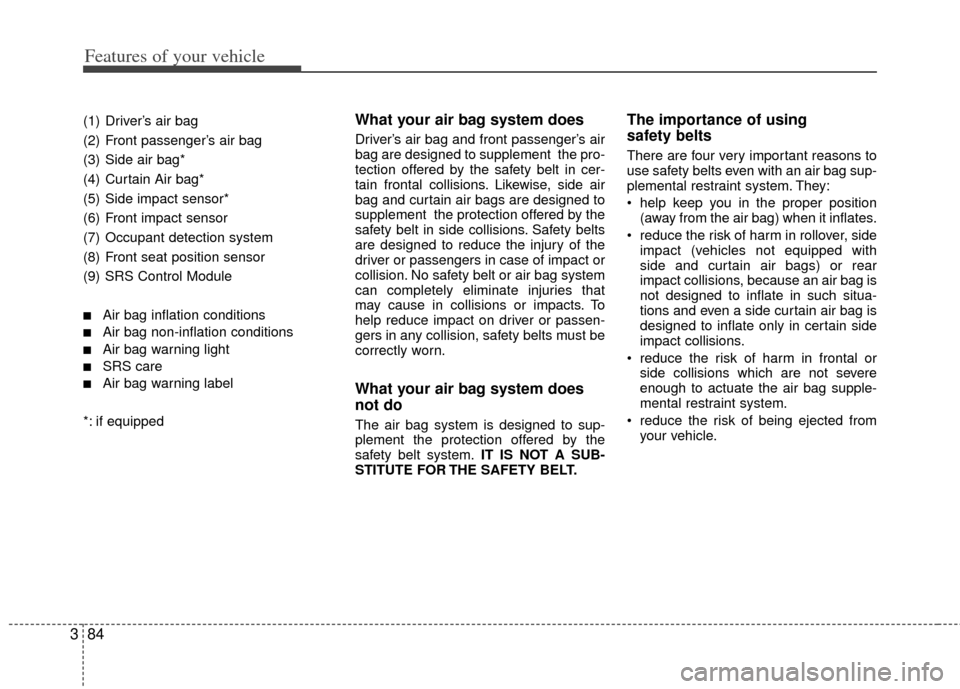
Features of your vehicle
84
3
(1) Driver’s air bag
(2) Front passenger’s air bag
(3) Side air bag*
(4) Curtain Air bag*
(5) Side impact sensor*
(6) Front impact sensor
(7) Occupant detection system
(8) Front seat position sensor
(9) SRS Control Module
■Air bag inflation conditions
■Air bag non-inflation conditions
■Air bag warning light
■SRS care
■Air bag warning label
*: if equipped
What your air bag system does
Driver’s air bag and front passenger’s air
bag are designed to supplement the pro-
tection offered by the safety belt in cer-
tain frontal collisions. Likewise, side air
bag and curtain air bags are designed to
supplement the protection offered by the
safety belt in side collisions. Safety belts
are designed to reduce the injury of the
driver or passengers in case of impact or
collision. No safety belt or air bag system
can completely eliminate injuries that
may cause in collisions or impacts. To
help reduce impact on driver or passen-
gers in any collision, safety belts must be
correctly worn.
What your air bag system does
not do
The air bag system is designed to sup-
plement the protection offered by the
safety belt system. IT IS NOT A SUB-
STITUTE FOR THE SAFETY BELT.
The importance of using
safety belts
There are four very important reasons to
use safety belts even with an air bag sup-
plemental restraint system. They:
help keep you in the proper position (away from the air bag) when it inflates.
reduce the risk of harm in rollover, side impact (vehicles not equipped with
side and curtain air bags) or rear
impact collisions, because an air bag is
not designed to inflate in such situa-
tions and even a side curtain air bag is
designed to inflate only in certain side
impact collisions.
reduce the risk of harm in frontal or side collisions which are not severe
enough to actuate the air bag supple-
mental restraint system.
reduce the risk of being ejected from your vehicle.
Page 96 of 382
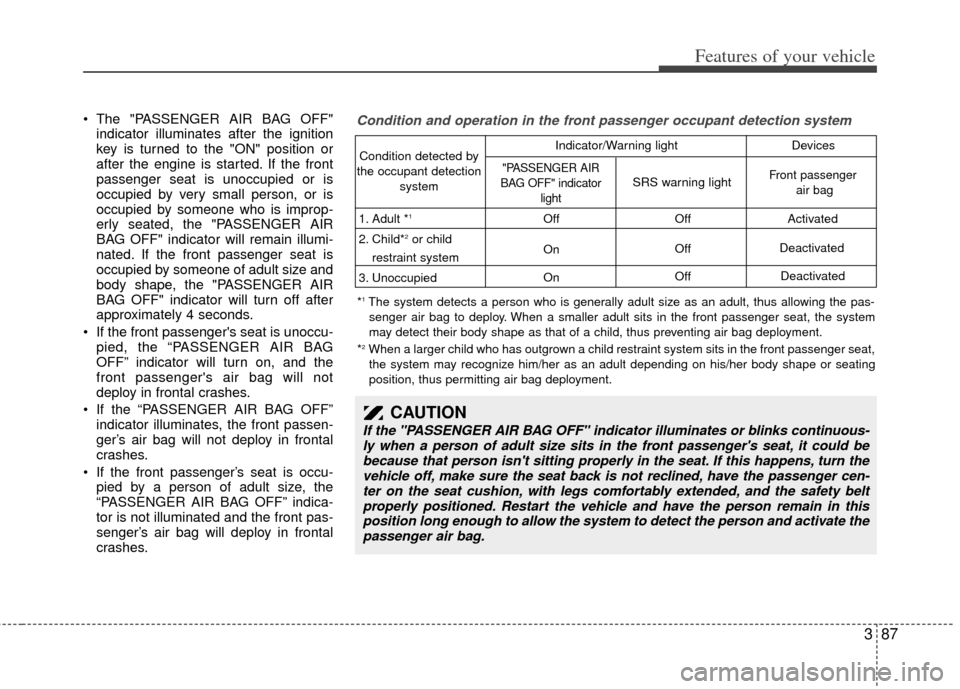
387
Features of your vehicle
The "PASSENGER AIR BAG OFF"indicator illuminates after the ignition
key is turned to the "ON" position or
after the engine is started. If the front
passenger seat is unoccupied or is
occupied by very small person, or is
occupied by someone who is improp-
erly seated, the "PASSENGER AIR
BAG OFF" indicator will remain illumi-
nated. If the front passenger seat is
occupied by someone of adult size and
body shape, the "PASSENGER AIR
BAG OFF" indicator will turn off after
approximately 4 seconds.
If the front passenger's seat is unoccu- pied, the “PASSENGER AIR BAG
OFF” indicator will turn on, and the
front passenger's air bag will not
deploy in frontal crashes.
If the “PASSENGER AIR BAG OFF” indicator illuminates, the front passen-
ger’s air bag will not deploy in frontal
crashes.
If the front passenger’s seat is occu- pied by a person of adult size, the
“PASSENGER AIR BAG OFF” indica-
tor is not illuminated and the front pas-
senger’s air bag will deploy in frontal
crashes.Condition and operation in the front passenger occupant detection system
Condition detected by
the occupant detection system
1. Adult *
1
2. Child*2or child
restraint system
3. Unoccupied Off
On
On
Off
Off
Off
Activated
Deactivated
"PASSENGER AIR
BAG OFF" indicator lightSRS warning lightFront passengerair bag
Deactivated
Indicator/Warning light Devices
*1The system detects a person who is generally adult size as an adult, thus allowing the pas-
senger air bag to deploy. When a smaller adult sits in the front passenger seat, the system
may detect their body shape as that of a child, thus preventing air bag deployment.
*
2When a larger child who has outgrown a child restraint system sits in the front passenger seat, the system may recognize him/her as an adult depending on his/her body shape or seating
position, thus permitting air bag deployment.
CAUTION
If the "PASSENGER AIR BAG OFF" indicator illuminates or blinks continuous- ly when a person of adult size sits in the front passenger's seat, it could bebecause that person isn't sitting properly in the seat. If this happens, turn thevehicle off, make sure the seat back is not reclined, have the passenger cen- ter on the seat cushion, with legs comfortably extended, and the safety beltproperly positioned. Restart the vehicle and have the person remain in this position long enough to allow the system to detect the person and activate thepassenger air bag.
Page 97 of 382
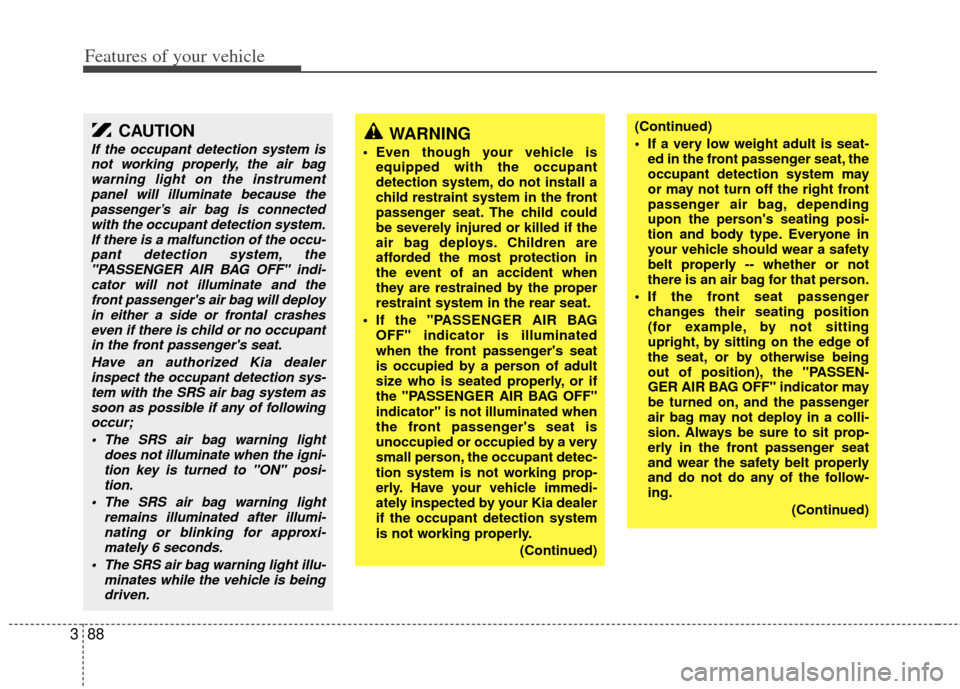
Features of your vehicle
88
3
WARNING
Even though your vehicle is
equipped with the occupant
detection system, do not install a
child restraint system in the front
passenger seat. The child could
be severely injured or killed if the
air bag deploys. Children are
afforded the most protection in
the event of an accident when
they are restrained by the proper
restraint system in the rear seat.
If the "PASSENGER AIR BAG OFF" indicator is illuminated
when the front passenger's seat
is occupied by a person of adult
size who is seated properly, or if
the "PASSENGER AIR BAG OFF"
indicator" is not illuminated when
the front passenger's seat is
unoccupied or occupied by a very
small person, the occupant detec-
tion system is not working prop-
erly. Have your vehicle immedi-
ately inspected by your Kia dealer
if the occupant detection system
is not working properly.
(Continued)
(Continued)
If a very low weight adult is seat-ed in the front passenger seat, the
occupant detection system may
or may not turn off the right front
passenger air bag, depending
upon the person's seating posi-
tion and body type. Everyone in
your vehicle should wear a safety
belt properly -- whether or not
there is an air bag for that person.
If the front seat passenger changes their seating position
(for example, by not sitting
upright, by sitting on the edge of
the seat, or by otherwise being
out of position), the "PASSEN-
GER AIR BAG OFF" indicator may
be turned on, and the passenger
air bag may not deploy in a colli-
sion. Always be sure to sit prop-
erly in the front passenger seat
and wear the safety belt properly
and do not do any of the follow-
ing.
(Continued)CAUTION
If the occupant detection system isnot working properly, the air bagwarning light on the instrumentpanel will illuminate because thepassenger’s air bag is connectedwith the occupant detection system. If there is a malfunction of the occu-pant detection system, the"PASSENGER AIR BAG OFF" indi-cator will not illuminate and thefront passenger's air bag will deployin either a side or frontal crasheseven if there is child or no occupantin the front passenger's seat.
Have an authorized Kia dealerinspect the occupant detection sys-tem with the SRS air bag system as soon as possible if any of followingoccur;
The SRS air bag warning light does not illuminate when the igni-tion key is turned to "ON" posi-tion.
The SRS air bag warning light remains illuminated after illumi-nating or blinking for approxi-mately 6 seconds.
The SRS air bag warning light illu- minates while the vehicle is beingdriven.
Page 101 of 382
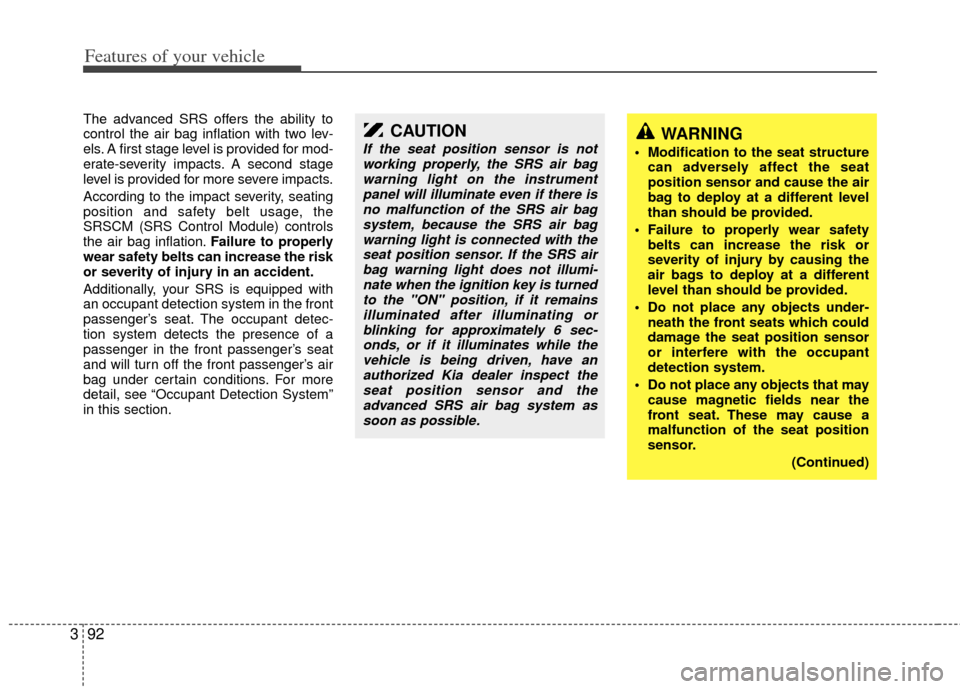
Features of your vehicle
92
3
The advanced SRS offers the ability to
control the air bag inflation with two lev-
els. A first stage level is provided for mod-
erate-severity impacts. A second stage
level is provided for more severe impacts.
According to the impact severity, seating
position and safety belt usage, the
SRSCM (SRS Control Module) controls
the air bag inflation. Failure to properly
wear safety belts can increase the risk
or severity of injury in an accident.
Additionally, your SRS is equipped with
an occupant detection system in the front
passenger’s seat. The occupant detec-
tion system detects the presence of a
passenger in the front passenger’s seat
and will turn off the front passenger’s air
bag under certain conditions. For more
detail, see “Occupant Detection System”
in this section.CAUTION
If the seat position sensor is not working properly, the SRS air bagwarning light on the instrumentpanel will illuminate even if there isno malfunction of the SRS air bag system, because the SRS air bagwarning light is connected with theseat position sensor. If the SRS airbag warning light does not illumi-nate when the ignition key is turnedto the "ON" position, if it remainsilluminated after illuminating orblinking for approximately 6 sec-onds, or if it illuminates while the vehicle is being driven, have anauthorized Kia dealer inspect theseat position sensor and theadvanced SRS air bag system assoon as possible.WARNING
Modification to the seat structure can adversely affect the seat
position sensor and cause the air
bag to deploy at a different level
than should be provided.
Failure to properly wear safety belts can increase the risk or
severity of injury by causing the
air bags to deploy at a different
level than should be provided.
Do not place any objects under- neath the front seats which could
damage the seat position sensor
or interfere with the occupant
detection system.
Do not place any objects that may cause magnetic fields near the
front seat. These may cause a
malfunction of the seat position
sensor.
(Continued)